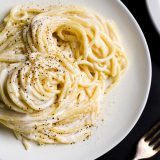Bologna is a mystery. Originally Etruscan, then Roman, now home to the oldest university in the world, it is a destination that, up until 10 years ago, was mostly overlooked by travelers. It wears its medieval clothing well, with stunning marble-faced arcades, leaning towers, cobblestone streets, fountains and narrow alleys filled with vegetable stands, fish markets and salumi vendors.
Underneath this showy exterior is the love of simplicity that underlies all Italian cooking. Yes, there are restaurants such as Massimiliano Poggi outside Bologna that remind one of the heady days of nouvelle cuisine. But for the most part, the cooks in Bologna stick to basics: fettuccine alla Bolognese, tortellini in brodo, passatelli, cotoletta, crespelle, ragùs, and the simplest of pastas, such as tagliatelle with butter and prosciutto.
Any good traveler is always on the lookout for that one dish, the game-changer, and the Emilia- Romagna region makes the perfect hunting ground. In my case, it was a Parmesan cream sauce I had with gramigna pasta at Trattoria Bertozzi in Bologna. It is so ridiculously simple—cream, grated Parmesan and lemon juice—that it barely qualifies as a recipe, yet it solves the problem of Alfredo, carbonara, cacio e pepe and other creamy pasta sauces that easily end up gluey, stringy or congealed.
Back at Milk Street, we made only two small changes: We added Parmesan rind to the cream along with two bay leaves to boost flavor. Once the cream had reduced at a low simmer, about 10 minutes, we whisked in the lemon juice—which helped thicken the cream—and then the cheese until the Parmesan melted into a fluid, creamy sauce. Nothing could be simpler, which for any Italian cook is the highest compliment.
Cream-based sauces such as the one in our pasta with Parmesan can be thickened naturally as they cook simply by adding lemon juice. That’s because the proteins in dairy react to acidity by clumping together, which gives the sauce a rich viscosity. The same chemical reaction is responsible for the thickness of sour cream, which is acidified as a result of the culturing process.
Related Recipes
September-October 2020

Sign up to receive texts
Successfully signed up to receive texts!
We'll only send our very best offers - Like a $15 store credit to start.
By entering your phone number and submitting this form, you consent to receive marketing text messages (such as promotion codes and cart reminders) from Christopher Kimball's Milk Street at the number provided, including messages sent by autodialer. Consent is not a condition of any purchase. Message and data rates may apply. Message frequency varies. You can unsubscribe at any time by replying STOP or clicking the unsubscribe link (where available) in one of our messages. View our Privacy Policy and Terms of Service.



